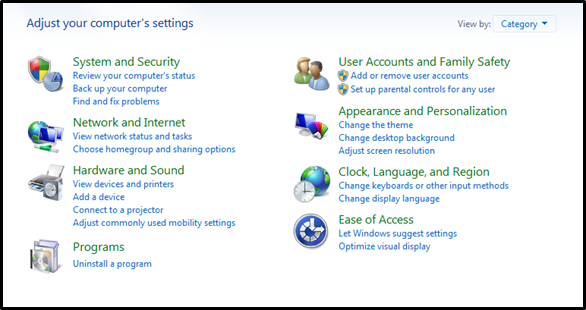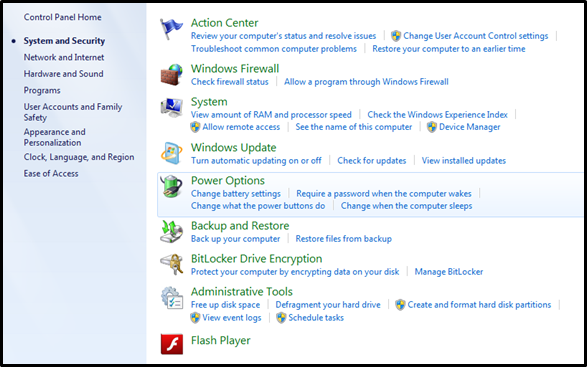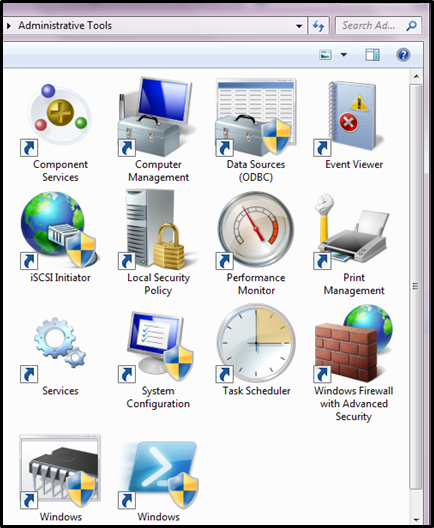4.2.4: Utility Programs
- Page ID
- 10109
\( \newcommand{\vecs}[1]{\overset { \scriptstyle \rightharpoonup} {\mathbf{#1}} } \)
\( \newcommand{\vecd}[1]{\overset{-\!-\!\rightharpoonup}{\vphantom{a}\smash {#1}}} \)
\( \newcommand{\id}{\mathrm{id}}\) \( \newcommand{\Span}{\mathrm{span}}\)
( \newcommand{\kernel}{\mathrm{null}\,}\) \( \newcommand{\range}{\mathrm{range}\,}\)
\( \newcommand{\RealPart}{\mathrm{Re}}\) \( \newcommand{\ImaginaryPart}{\mathrm{Im}}\)
\( \newcommand{\Argument}{\mathrm{Arg}}\) \( \newcommand{\norm}[1]{\| #1 \|}\)
\( \newcommand{\inner}[2]{\langle #1, #2 \rangle}\)
\( \newcommand{\Span}{\mathrm{span}}\)
\( \newcommand{\id}{\mathrm{id}}\)
\( \newcommand{\Span}{\mathrm{span}}\)
\( \newcommand{\kernel}{\mathrm{null}\,}\)
\( \newcommand{\range}{\mathrm{range}\,}\)
\( \newcommand{\RealPart}{\mathrm{Re}}\)
\( \newcommand{\ImaginaryPart}{\mathrm{Im}}\)
\( \newcommand{\Argument}{\mathrm{Arg}}\)
\( \newcommand{\norm}[1]{\| #1 \|}\)
\( \newcommand{\inner}[2]{\langle #1, #2 \rangle}\)
\( \newcommand{\Span}{\mathrm{span}}\) \( \newcommand{\AA}{\unicode[.8,0]{x212B}}\)
\( \newcommand{\vectorA}[1]{\vec{#1}} % arrow\)
\( \newcommand{\vectorAt}[1]{\vec{\text{#1}}} % arrow\)
\( \newcommand{\vectorB}[1]{\overset { \scriptstyle \rightharpoonup} {\mathbf{#1}} } \)
\( \newcommand{\vectorC}[1]{\textbf{#1}} \)
\( \newcommand{\vectorD}[1]{\overrightarrow{#1}} \)
\( \newcommand{\vectorDt}[1]{\overrightarrow{\text{#1}}} \)
\( \newcommand{\vectE}[1]{\overset{-\!-\!\rightharpoonup}{\vphantom{a}\smash{\mathbf {#1}}}} \)
\( \newcommand{\vecs}[1]{\overset { \scriptstyle \rightharpoonup} {\mathbf{#1}} } \)
\( \newcommand{\vecd}[1]{\overset{-\!-\!\rightharpoonup}{\vphantom{a}\smash {#1}}} \)
\(\newcommand{\avec}{\mathbf a}\) \(\newcommand{\bvec}{\mathbf b}\) \(\newcommand{\cvec}{\mathbf c}\) \(\newcommand{\dvec}{\mathbf d}\) \(\newcommand{\dtil}{\widetilde{\mathbf d}}\) \(\newcommand{\evec}{\mathbf e}\) \(\newcommand{\fvec}{\mathbf f}\) \(\newcommand{\nvec}{\mathbf n}\) \(\newcommand{\pvec}{\mathbf p}\) \(\newcommand{\qvec}{\mathbf q}\) \(\newcommand{\svec}{\mathbf s}\) \(\newcommand{\tvec}{\mathbf t}\) \(\newcommand{\uvec}{\mathbf u}\) \(\newcommand{\vvec}{\mathbf v}\) \(\newcommand{\wvec}{\mathbf w}\) \(\newcommand{\xvec}{\mathbf x}\) \(\newcommand{\yvec}{\mathbf y}\) \(\newcommand{\zvec}{\mathbf z}\) \(\newcommand{\rvec}{\mathbf r}\) \(\newcommand{\mvec}{\mathbf m}\) \(\newcommand{\zerovec}{\mathbf 0}\) \(\newcommand{\onevec}{\mathbf 1}\) \(\newcommand{\real}{\mathbb R}\) \(\newcommand{\twovec}[2]{\left[\begin{array}{r}#1 \\ #2 \end{array}\right]}\) \(\newcommand{\ctwovec}[2]{\left[\begin{array}{c}#1 \\ #2 \end{array}\right]}\) \(\newcommand{\threevec}[3]{\left[\begin{array}{r}#1 \\ #2 \\ #3 \end{array}\right]}\) \(\newcommand{\cthreevec}[3]{\left[\begin{array}{c}#1 \\ #2 \\ #3 \end{array}\right]}\) \(\newcommand{\fourvec}[4]{\left[\begin{array}{r}#1 \\ #2 \\ #3 \\ #4 \end{array}\right]}\) \(\newcommand{\cfourvec}[4]{\left[\begin{array}{c}#1 \\ #2 \\ #3 \\ #4 \end{array}\right]}\) \(\newcommand{\fivevec}[5]{\left[\begin{array}{r}#1 \\ #2 \\ #3 \\ #4 \\ #5 \\ \end{array}\right]}\) \(\newcommand{\cfivevec}[5]{\left[\begin{array}{c}#1 \\ #2 \\ #3 \\ #4 \\ #5 \\ \end{array}\right]}\) \(\newcommand{\mattwo}[4]{\left[\begin{array}{rr}#1 \amp #2 \\ #3 \amp #4 \\ \end{array}\right]}\) \(\newcommand{\laspan}[1]{\text{Span}\{#1\}}\) \(\newcommand{\bcal}{\cal B}\) \(\newcommand{\ccal}{\cal C}\) \(\newcommand{\scal}{\cal S}\) \(\newcommand{\wcal}{\cal W}\) \(\newcommand{\ecal}{\cal E}\) \(\newcommand{\coords}[2]{\left\{#1\right\}_{#2}}\) \(\newcommand{\gray}[1]{\color{gray}{#1}}\) \(\newcommand{\lgray}[1]{\color{lightgray}{#1}}\) \(\newcommand{\rank}{\operatorname{rank}}\) \(\newcommand{\row}{\text{Row}}\) \(\newcommand{\col}{\text{Col}}\) \(\renewcommand{\row}{\text{Row}}\) \(\newcommand{\nul}{\text{Nul}}\) \(\newcommand{\var}{\text{Var}}\) \(\newcommand{\corr}{\text{corr}}\) \(\newcommand{\len}[1]{\left|#1\right|}\) \(\newcommand{\bbar}{\overline{\bvec}}\) \(\newcommand{\bhat}{\widehat{\bvec}}\) \(\newcommand{\bperp}{\bvec^\perp}\) \(\newcommand{\xhat}{\widehat{\xvec}}\) \(\newcommand{\vhat}{\widehat{\vvec}}\) \(\newcommand{\uhat}{\widehat{\uvec}}\) \(\newcommand{\what}{\widehat{\wvec}}\) \(\newcommand{\Sighat}{\widehat{\Sigma}}\) \(\newcommand{\lt}{<}\) \(\newcommand{\gt}{>}\) \(\newcommand{\amp}{&}\) \(\definecolor{fillinmathshade}{gray}{0.9}\)Learning Objectives
- Identify utility programs included with an operating system and describe their purpose.
A utility program is a system software package that is designed to assist in the analysis, configuration, optimization, or maintenance of a computing system. A utility program may be packaged along with the OS, or it might be purchased separately. The utility programs are specific to the OS and the platform on which the OS is running. There are similarities in some of the tasks that these utilities perform, but some operate with only one type of OS.
On a Windows-based system, you will find many of the utilities that are packaged with this OS via the Control Panel. On a Windows 7 system, 51 utilities are listed. The general categories of utilities include the following:

Image courtesy of Microsoft.
Alternative version
And clicking on any one of the categories displays a partial list of the utilities that each category contains:

Image courtesy of Microsoft.
Alternative version
What kinds of tasks might you find in each category? The titles are quite explanatory in this category view, and the tasks listed in the category view are the ones you are most likely to use. But you can dig further by clicking on any one of the categories to see all of the utilities contained in that specific category. For example, under Administrative Tools, in addition to the five items listed in the category view, you have access to all of these:

Image courtesy of Microsoft.
Alternative version
Clicking on any one of the icons displays a list of the actions you can take with this utility.
What about the utilities provided by the Mac OS? Are they similar, or are they radically different? The utilities that Apple includes with the Mac OS include a task scheduler; an analyzer that details the system status; and utilities for tracking processor and memory usage, setting up access to a wireless network, controlling audio devices, managing color for the screen display, tracking system messages, managing the hard drive, screen capturing, securely storing passwords, migrating files from one Mac system to another, file compression, and network setup (Apple, 2013). Most of these definitely sound like those provided with a Window-based system. If you already have a Mac, click on Applications in the Finder tool. Or visit the Apple Apps store to see apps that are available for downloading.
There are many utilities that support Linux-based systems, but many are command-line utilities; that is, instructions or small sets of code that you type directly onto the screen to activate the utility. Just about everything you do on a Linux system—from finding things in files to checking the status of your system to performing a backup of your files—is a utility. This means that the user types in a command such as “cal 2014,” which will display a calendar for the year 2014. Basic utilities such as those that support file management, archiving, and text manipulation are part of all variants of Linux (Ubuntu, for example). In addition, there are many commercial Linux utilities, some of which are free, open-source packages, that you can download from distributor sites (Wilburn, 2000). These newer commercial utilities come with an icon-based interface.
Utilities are not limited to those that are packaged with a particular OS. You can download (sometimes for free, sometimes for a fee) or purchase many other utilities for your computer. Some such utilities fall into the categories of games, books and reference, comics, education, entertainment, finance, health and fitness, lifestyle, media and video, music and audio, news and magazines, photography, shopping, social, sports, tools, travel, weather, and widgets. The list is extensive, and a search of websites for utility programs will provide you with an incredible list of options for PCs, Macs, tablets, smartphones, and more.
learn by doing
Which of the following wouldnotbe considered a system utility that is bundled with an OS?
True or false? You will find that utility programs such as one that sets up access to a wireless network are packaged with any of the major operating systems.
True or false? The Linux OS does not come with system utilities. Instead, the user either downloads these from provider sites or creates them via a command line instruction.
Reset this Activity
Maintaining your computer will provide you with improved performance. In this list of actions you can take to maintain your system, which action would most likelynotbe supported by asystemutility?
You want to ensure that you do not lose important files and data if your system experiences failure. Which system utility would you use for this?
You have subscribed to an online magazine and are using a utility to view the magazine on your computer. The site offers a download of the required utility. You are most likely using a .
Reset this Activity
References
- OS X Apps (2013). Retrieved August 8, 2013, from Apple: http://www.apple.com/osx/apps/.
- Wilburn, G. (2000, May). Linux Inside: Utilities, the heart and soul of Linux. Retrieved August 15, 2013, from Linux Inside: www.northernjourney.com/opens...ide/li010.html.

